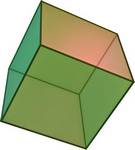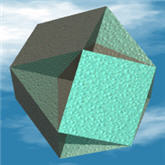Euler's Formula
(There is another "Euler's Formula" about complex numbers,
this page is about the one used in Geometry and Graphs)
this page is about the one used in Geometry and Graphs)
Euler's Formula
For any polyhedron that doesn't intersect itself, the
- Number of Faces
- plus the Number of Vertices (corner points)
- minus the Number of Edges
always equals 2
This can be written: F + V - E = 2
 | Try it on the cube: A cube has 6 Faces, 8 Vertices, and 12 Edges, so: 6 + 8 - 12 = 2 |
To see why this works, imagine taking the cube and adding an edge (say from corner to corner of one face). You will have an extra edge, plus an extra face: 7 + 8 - 13 = 2 |  |
Likewise if you included another vertex (say halfway along a line) you would get an extra edge, too. 6 + 9 - 13 = 2. "No matter what you do, you always end up with 2" (But only for this type of Polyhedron ... read on!) |  |
Example With Platonic Solids
Let's try with the 5 Platonic Solids (Note: Euler's Formula can be used to prove that there are only 5 Platonic Solids):
| Name | Faces | Vertices | Edges | F+V-E | |
|---|---|---|---|---|---|
| Tetrahedron | 4 | 4 | 6 | 2 | |
| Cube |  | 6 | 8 | 12 | 2 |
| Octahedron |  | 8 | 6 | 12 | 2 |
| Dodecahedron | 12 | 20 | 30 | 2 | |
| Icosahedron | 20 | 12 | 30 | 2 |
The Sphere
 | All Platonic Solids (and many other solids) are like a Sphere ... you can reshape them so that they become a Sphere (move their corner points, then curve their faces a bit). For this reason we know that F+V-E = 2 for a sphere |
(BE careful, you can not simply say a sphere has 1 face, and 0 vertices and edges, for F+V-E=1)
So, the result is 2 again ...
... But Not Always ...
Now that you see how this works, I am going to show you how it doesn't work ...!
What if I joined up two opposite corners of the icosahedron? It is still an icosahedron (but no longer convex). In fact it looks a bit like a drum where someone has stitched the top and bottom together. Now, there would be the same number of edges and faces ... but one less vertex! So: F + V - E = 1 Oh No! It doesn't always add to 2! |
The reason it didn't work was that this new shape is basically different ... that joined bit in the middle means that two vertices get reduced to 1.
Euler Characteristic
So, F+V-E can equal 2, or 1, and maybe other values, so the more general formula is
F + V - E = χ
Where χ is called the "Euler Characteristic".
Here are a few examples:
| Shape | χ | |
|---|---|---|
| Sphere |  | 2 |
| Torus |  | 0 |
| Mobius Strip |  | 0 |
 | And the Euler Characteristic can also be less than zero. This is the "Cubohemioctahedron": It has 10 Faces (it may look like more, but some of the "inside" faces are really just one face), 24 Edges and 12 Vertices, so: F + V - E = -2 |
In fact the Euler Characteristic is a basic idea in Topology (the study of the Nature of Space).
Donut and Coffee Cup
Lastly, this discussion would be incomplete without showing you that a Donut and a Coffee Cup are really the same! Well, they can be deformed into one another. We say the two objects are "homeomorphic" (from Greekhomoios = identical and morphe = shape) Just like the platonic solids are homeomorphic to the sphere. (Animation courtesy of Wikipedia User:Kieff) |
No comments:
Post a Comment